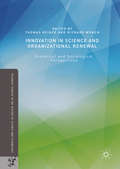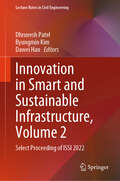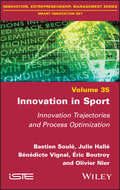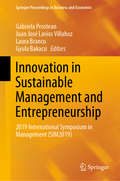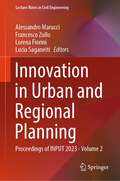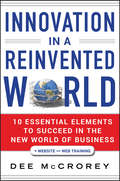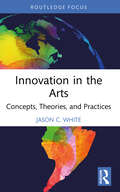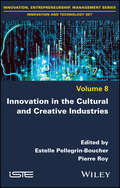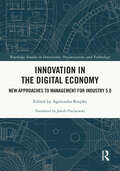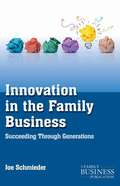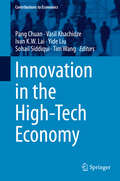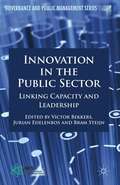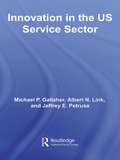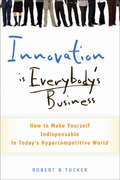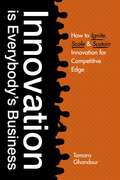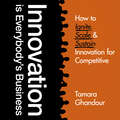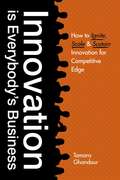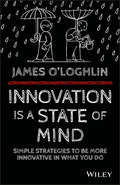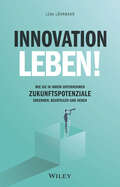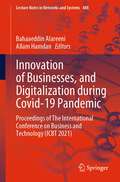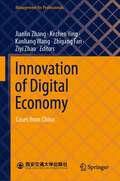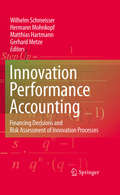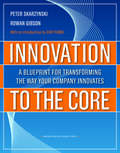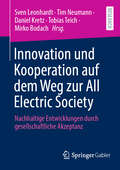- Table View
- List View
Innovation in Science and Organizational Renewal
by Thomas Heinze Richard MünchThis book looks at the types of new research organizations that drive scientific innovation and how ground-breaking science transforms research fields and their organization. Based on historical case studies and comparative empirical data, the book presents new and thought-provoking evidence that improves our knowledge and understanding about how new research fields are formed and how research organizations adapt to breakthroughs in science. While the book is firmly based in science history, it discusses more general sociological and policy propositions regarding scientific innovations and organizational change. The volume brings together leading scholars both from the United States and Europe.
Innovation in Smart and Sustainable Infrastructure, Volume 2: Select Proceeding of ISSI 2022 (Lecture Notes in Civil Engineering #485)
by Dawei Han Dhruvesh Patel Byungmin KimThis book presents select peer-reviewed proceedings of the International Conference on Innovation in Smart and Sustainable Infrastructure (ISSI2022). The contents focus on smart infrastructure and cites, construction and infrastructure project management, application of building information modelling, sustainable materials and methods for road construction, smart technologies, applications and services for transportation systems, remote sensing and GIS for water resources management, climate change and prediction analysis, model simulation and analysis, seismic engineering and soil dynamics, innovation geo-materials and geosynthetics, computational geotechnics, emerging technologies in smart mobility and transport planning, among others. This volume will be useful for researchers and professionals in civil engineering and allied fields.
Innovation in Sport: Innovation Trajectories and Process Optimization
by Bastien Soule Julie Halle Benedicte Vignal Eric Boutroy Olivier NierWhether in terms of practices, equipment or services, the sports sector is characterized by intense inventiveness and is an excellent subject to study innovation processes. This book provides a sociological reading of these processes, illustrated by case studies that allow us to grasp the complexity of innovation trajectories. The case studies highlight the astonishing pathways, from the origin of inventions to their effective dissemination and use, and including the bifurcations of projects. The “surprises” thus presented refer to an invariant of innovation processes, namely that trajectories are rarely linear and that the control exercised over them is relative. Innovation in Sport concludes with a set of recommendations for optimizing the management of sport innovation. This book is intended for students of sports science and management, as well as for professionals and entrepreneurs in the sports markets.
Innovation in Sustainable Management and Entrepreneurship: 2019 International Symposium in Management (SIM2019) (Springer Proceedings in Business and Economics)
by Gabriela Prostean Juan José Lavios Villahoz Laura Brancu Gyula BakacsiThis book analyses state-of-the-art techniques in business process management as drivers of advanced entrepreneurship, financial management, supply chain management, and sustainability management. The role of management in a rapidly-changing environment and the use of innovative methods and techniques to address and solve key management problems are also explored.
Innovation in Urban and Regional Planning: Proceedings of INPUT 2023 - Volume 2 (Lecture Notes in Civil Engineering #463)
by Alessandro Marucci Francesco Zullo Lorena Fiorini Lucia SaganeitiThis book gathers the proceedings of the INPUT2023 Conference on ‘Innovation in Urban and Regional Planning.’ The 12th International Conference INPUT was held at the University of L'Aquila, Italy, on September 6–8, 2023, and brought together international scholars in the fields of planning, civil engineering and architecture, ecology, and social science, to strengthen the knowledge on nature-based solutions and to enhance the implementation and replication of these solutions in different contexts. The book represents the state of the art of modeling and computational approaches to innovations in urban and regional planning, with a transdisciplinary and borderless character to address the complexity of contemporary socio-ecological systems and following a practice-oriented and problem-solving approach. Computational tools, technologies, data, mathematical models, and decision support tools are explored for providing innovative spatial planningmodeling methodologies.
Innovation in a Reinvented World
by Dee MccroreyA step-by-step guide to the 10 essential and practical skills a business needs to innovate and thrive in uncertain times The reinvented world of business will profoundly impact America's leaders and workers in the decade ahead. Companies capable of transforming their organizations during this period of "Great Disruption" will thrive in the reinvented world however, the reverse holds true as well. Innovation in a Reinvented World reveals how transformation occurs when business leaders and their organizations apply these 10 Essential Elements, providing both a road map and definitive blueprint for companies of any size looking to bridge the old world with the new world of business. Discusses the "new courage" required for innovating in a reinvented world Looks at 10 Essential Elements winning companies count on today Innovation in a Reinvented World helps executives and leadership teams navigate and manage their organizations' inflection points in designing, building, and sustaining innovation--even through the post-recession playing field.
Innovation in the Arts: Concepts, Theories, and Practices (Routledge Focus on the Global Creative Economy)
by Jason C. WhiteThis concise guide aims to increase what we understand by innovation in the arts and identify and support opportunities and strategies for the unique ways in which artists and arts administrators think about, engage in, and pursue successful innovation in their diverse creative practice. Innovations in the Arts are often marginalised from a research perspective, in part because of the lack of a sound and compelling theoretical framework to support and explain process distinctions from business and management innovation. This book identifies three key concepts - art innovation, art movement innovation, and audience experience innovation - supported by formal theory for each concept presented and evidenced through case studies in art history. In this way, the book enables readers to identify, explain, and support their innovation efforts as visual, literary, and performing artists and arts administrators. It also explores strategies for pursuing innovation in practice. Drawing attention to the unique ways in which artists and arts administrators think about and engage in innovation, this readable book will be an essential reading for students in all aspects of the creative and cultural industries and an essential guide to developing and promoting innovation in the arts for practitioners and researchers alike.
Innovation in the Cultural and Creative Industries
by Pierre Roy Estelle Pellegrin-BoucherTechnological innovations, sociological and consumer trends, and growing internationalization are transforming the cultural and creative industries (CCIs). These changes present new challenges for CCIs that require original and inventive answers. Innovation in the Cultural and Creative Industries analyzes the powerful strategies put in place by CCI organizations such as Nintendo, the Lascaux Cave and Daft Punk. The case studies presented in this book cover video games, books, music, museums, fashion, film and architecture. Each chapter is organized around five key points: a theoretical framework that focuses on a specific concept, a description of the methodological mechanism mobilized, a presentation of the industry concerned, the analysis of the innovative strategy and a recap of the lessons and best practices demonstrated by the case.
Innovation in the Digital Economy: New Approaches to Management for Industry 5.0 (Routledge Studies in Innovation, Organizations and Technology)
by Agnieszka Rzepka Jakub PrachowskiThe rapidly changing world requires constant revisions and adaptations to existing business strategies and models. The emerging industry 5.0 reality is forcing companies to transition to a more sustainable, human-centric, and resilient industry through innovation. This book presents concrete business models and practical frameworks to assist managers in developing and implementing innovative and robust businesses, both globally and locally. This edited collection compiles an experienced team of contributing authors with diverse academic backgrounds who cover a range of topics on different aspects of innovation, from exploring the challenges associated with industry 5.0 to incorporating artificial intelligence in modeling consumer behavior. Based on the experiences and challenges posed by recent economic developments and recovery from the COVID-19 pandemic, the book offers the reader a chance to read case studies from global companies that have successfully implemented new innovations. Thanks to a rigorous research methodology in accordance with principles and standards recognized by the DAC Network, the book provides an actionable road map on how to change one’s innovation strategy techniques in light of changing business conditions. Innovation in the Digital Economy will be of direct interest to scholars and subject matter experts in the field of innovation management. Business leaders and reflective practitioners will find the content relevant and accessible.
Innovation in the Family Business
by Joe SchmiederSchmieder shares a broad range of tools and pathways that family businesses across sectors use to stimulate, execute, measure, and reward innovation. The 50-plus family stories cited in this book will inspire any family enterprise to create a strategy and environment that can stimulate success for many generations to come.
Innovation in the High-Tech Economy
by Tim Wang Pang Chuan Vasil Khachidze Ivan K. W. Lai Yide Liu Sohail SiddiquiThis book constitutes the proceedings of the First International Conference on Management Science and Engineering: Innovation and High-tech Services, ICMSE 2013, held in Macau, in June 2013. The papers are contributed by innovative researchers, engineers and practitioners in the field of management science, information system, finance, economics and accounting and offer a platform for exchanging the latest research findings in the field of management science and management innovation, for looking forward to the future trends in the management science and management innovation field in the 21st century, and to promote management modernization and high-tech innovation services.
Innovation in the Public Sector
by Victor Bekkers Jurian Edelenbos Bram SteijnAddresses issues relevant to an understanding of the innovation journeys on which public organizations have embarked. If public innovation is defined as a necessary condition for establishing meaningful interactions between the government and society what are the relevant issues that may explain successful processes and forms of public innovation?
Innovation in the U.S. Service Sector (Routledge Studies in Innovation, Organizations and Technology)
by Albert N. Link Michael P. Gallaher Jeffrey E. PetrusaUsing a cutting-edge structure, where a current description of the service sector and up-to-date case studies are compared and contrasted with innovative activity in manufacturing, this book contributes towards a better theoretical understanding of innovation in the U.S. service sector. The U.S. service sector is the largest sector in the U.S. economy and accounts for an increasingly significant share of U.S. gross domestic product, currently 68 percent. Both in the United States, as well as in other industrialized nations, the service sector is a dynamic component of economic activity and growth. As pervasive and economically important as the service sector is, innovative activity in service-sector firms remains somewhat of an enigma; it is not well understood and not well defined because it differs dramatically from the traditional model of innovation in manufacturing. Innovation in the U.S. Service Sector fills this void, placing emphasis on the United States, but with global relevance. It is essential reading for all students of business and management, economics and political science.
Innovation is Everybody's Business: How To Make Yourself Indispensable In Today's Hypercompetitive World
by Tucker Robert B.Innovation isn't something you do after you get your work done. It's how you do your work. Organizations all over the world are shedding jobs in record numbers. Yet today, they are desperately in need of people with the abilities and skills to think ahead of the curve, delight customers, motivate colleagues, slash costs, and achieve unconventional results. In this practical road map to becoming irreplaceable, global innovation guru and bestselling author Robert B. Tucker reveals why honing your I-Skills (Innovation Skills) may be the smartest career move you'll make. Based on interviews with forty-three innovation-adept managers and individual contributors, Innovation Is Everybody's Business guides you in: Mastering the seven essential I-Skills you need to become indispensable Unleashing the "mindset, skillset, and toolset of the innovator" that enable you to anticipate and rise to the challenges your organization faces in a hypercompetitive era Developing your Personal Innovation Strategy to address the critical components of becoming irreplaceable Assaulting your assumptions at the personal, organizational, and industry levels Building tools for work-life balance and creating your own job satisfaction If you're ready to stop talking about innovation and start adding value today - in your job, department or organization - you're ready to read and benefit from the powerful message of Innovation is Everybody's Business.
Innovation is Everybody's Business: How to ignite, scale, and sustain innovation for competitive edge
by Tamara GhandourTamara Ghandour, author, podcaster, keynote speaker and founder of innovation training company, LaunchStreet, used to believe that innovation was the domain of a select few, exclusive to certain industries, or relegated to a specific job role. But, as Tamara discovered in her 25 years of work and research, everybody has the capacity to innovate. It's a person's unique innovation style, which can be assessed and channelled, that can transform inertia into innovation.Drawing on eye-opening data from her proprietary Innovation Quotient Edge Assessment, Innovation is Everybody's Business is for those looking for solutions to the daily pain of "how do I prove my worth," a reality for many people whether they work in the C-Suite or on the front-lines. This book will resonate with those that recognize that being more innovative is their ticket to being indispensable. It is also for leaders under pressure to build a culture of innovation but don't know how. As organizations face pressure to innovate, the accountability for making it happen falls on senior and mid-level leaders. They are told what to do, but not how to do it. This book will give them a tool to build a team of innovators who make an impact every day in big and small ways.
Innovation is Everybody's Business: How to ignite, scale, and sustain innovation for competitive edge
by Tamara GhandourTamara Ghandour, author, podcaster, keynote speaker and founder of innovation training company, LaunchStreet, used to believe that innovation was the domain of a select few, exclusive to certain industries, or relegated to a specific job role. But, as Tamara discovered in her 25 years of work and research, everybody has the capacity to innovate. It's a person's unique innovation style, which can be assessed and channelled, that can transform inertia into innovation.Drawing on eye-opening data from her proprietary Innovation Quotient Edge Assessment, Innovation is Everybody's Business is for those looking for solutions to the daily pain of "how do I prove my worth," a reality for many people whether they work in the C-Suite or on the front-lines. This book will resonate with those that recognize that being more innovative is their ticket to being indispensable. It is also for leaders under pressure to build a culture of innovation but don't know how. As organizations face pressure to innovate, the accountability for making it happen falls on senior and mid-level leaders. They are told what to do, but not how to do it. This book will give them a tool to build a team of innovators who make an impact every day in big and small ways.(P) 2020 Hodder & Stoughton Ltd
Innovation is Everybody¿s Business: How to Ignite, Scale, and Sustain Innovation for Competitive Edge
by Tamara GhandourTamara Ghandour, author, podcaster, keynote speaker and founder of innovation training company, LaunchStreet, used to believe that innovation was the domain of a select few, exclusive to certain industries, or relegated to a specific job role. But, as Tamara discovered in her 25 years of work and research, everybody has the capacity to innovate. It's a person's unique innovation style, (which can be assessed and channelled), that can transform inertia into innovation.Drawing on eye-opening data from her proprietary Innovation Quotient Edge Assessment, Innovation is Everybody's Business is for those looking for solutions to the daily pain of "how do I prove my worth," a reality for many people whether they work in the C-Suite or on the front-lines. This book will resonate with those that recognize that being more innovative is their ticket to being indispensable. It is also for leaders under pressure to build a culture of innovation but don't know how. As organizations face pressure to innovate, the accountability for making it happen falls on senior and mid-level leaders. They are told what to do, but not how to do it. This book will give them a tool to build a team of innovators who make an impact every day in big and small ways.
Innovation is a State of Mind
by James O'LoghlinA modern framework for practical innovation--from individual ideas to an innovative organisational culture Everyone says that innovation is important. The problem is that no one tells you how to be innovative. Innovation is a State of Mind sets out a step-by-step guide to creating innovative ideas and putting them into action. You'll learn how to generate more ideas with greater potential, how to grow and evaluate them, test their effectiveness and then implement the ones that are going to improve your business. Author James O'Loghlin has worked with over a thousand of Australia's best inventors and innovators in the eight years he hosted ABC-TV's The New Inventors. He studied what they do differently and how they are able to identify and take advantage of opportunities that the rest of us miss. Packed with engaging stories and a good dose of humour, this insightful guide helps you to make innovation a part of what you do every day. Change your thinking and identify overlooked opportunities Step around common roadblocks to innovation Generate better ideas, and find the ones that will improve your business Create a culture where innovation is part of everyone's job Harvest innovative ideas from the entire staff and find the ones that will make a difference Innovators see things differently. They solve problems that the rest of us can't, and create solutions to problems that we never noticed we had. Getting stuck in routine and procedure is the death knell for modern business. Most companies undervalue and underuse the creative potential of their people, because they underestimate the impact of continuous innovation. Innovation is a State of Mind shows you how to think like an innovator and create a culture of innovation, so you can stay out in front of the future of business.
Innovation leben!: Wie Sie in Ihrem Unternehmen Zukunftspotenziale erkennen, beurteilen und heben
by Lena LuhrmannInnovation ist ein Wettlauf gegen Mitbewerber und gegen die große überall lauernde Unbekannte, die Überflüssigwerdung. Der Druck im Nacken, auch zu denen an der Spitze zu gehören, die schlaflosen Nächte, wenn man merkt, dass das Innovationsbestreben wieder mal vertagt worden ist, weil es, oberflächlich betrachtet, nicht drängt. Die Angst, dass man eines Morgens aufwacht, der Markt gekippt ist und man von heute auf morgen von einem 10 Personen Start-up aus einer Garage in Wanne Eickel überholt worden ist. Dieses Buch hilft, aus einer anderen Perspektive auf das Thema Innovation zu blicken - und zwar auf allen Hierachieebenen und aus Sicht verschiedener Bereiche, in denen Innovationen eine Rolle spielen. Es beleuchtet, woran Innovation immer noch und immer wieder scheitert, obwohl alle notwendigen Techniken und Budgets aufgefahren wurden. Lena Lührmann zeigt, was auf Bauch- und Kopfebene, zwischenmenschlich und haptisch passiert, wenn Menschen an Innovation denken oder sich damit befassen. Sie möchte so das Bewusstsein bei Führungskräften und Entscheidern in Unternehmen dafür wecken, was ihre Mitarbeiter in Sachen Innovation leisten oder auch nicht. Nur wenn die Leser sich selbst und ihr Unternehmen in dieser Hinsicht verstehen, werden sie in der Lage sein, aus allen wirklich großartigen Techniken die für sie passende herauszufinden. Anhand vieler "Aha-Momente" werden sie die im Buch beschriebenen Problematiken aus der Praxis in ihrem eigenen Unternehmen identifizieren und angehen können. Ziel soll sein: - Innovationsfähigkeitslevel beurteilen, - Innovationchancen erkennen, - Innovation mitmachen, - Innovation beurteilen, - Innovation leben, ganz natürlich aus dem Selbstverständnis des Unternehmens heraus. Jedes Kapitel umfasst drei Aspekte, um sich dem Thema zu nähern: Key Aussagen, Fakten und Lösungen, persönliche Erlebnisse der Autorin.
Innovation of Businesses, and Digitalization during Covid-19 Pandemic: Proceedings of The International Conference on Business and Technology (ICBT 2021) (Lecture Notes in Networks and Systems #488)
by Allam Hamdan Bahaaeddin AlareeniThis book constitutes the refereed proceedings of the International Conference on Business and Technology (ICBT2021) organized by EuroMid Academy of Business & Technology (EMABT), held in Istanbul, between 06–07 November 2021. In response to the call for papers for ICBT2021, 485 papers were submitted for presentation and inclusion in the proceedings of the conference. After a careful blind refereeing process, 292 papers were selected for inclusion in the conference proceedings from forty countries. Each of these chapters was evaluated through an editorial board, and each chapter was passed through a double-blind peer-review process.The book highlights a range of topics in the fields of technology, entrepreneurship, business administration, accounting, and economics that can contribute to business development in countries, such as learning machines, artificial intelligence, big data, deep learning, game-based learning, management information system, accounting information system, knowledge management, entrepreneurship, and social enterprise, corporate social responsibility and sustainability, business policy and strategic management, international management and organizations, organizational behavior and HRM, operations management and logistics research, controversial issues in management and organizations, turnaround, corporate entrepreneurship, innovation, legal issues, business ethics, and firm gerial accounting and firm financial affairs, non-traditional research, and creative methodologies.These proceedings are reflecting quality research contributing theoretical and practical implications, for those who are wise to apply the technology within any business sector. It is our hope that the contribution of this book proceedings will be of the academic level which even decision-makers in the various economic and executive-level will get to appreciate.
Innovation of Digital Economy: Cases from China (Management for Professionals)
by Kanliang Wang Jianlin Zhang Kezhen Ying Zhigang Fan Ziyi ZhaoThis book presents a rich selection of 36 real-world cases on how organizations in China explore the new growth pattern, business model innovation, and digital transformation in digital era. The topic of cases varies from digital marketing and Internet brands, the growth of digital platforms, digital transformation and the industrial Internet of things, strategies for cross-border e-commerce companies, and business model innovation in digital era, etc. These cases stem from a diverse set of industry sectors, reporting on best practices and lessons learned. The book shows how organizations strive to find new ways to develop and create new paths to grow in a digital world and shares essential practical insights into digital economy. All cases are presented in a standardized structure in order to provide valuable insights and essential guidance for practitioners, scholars as well as general readers.
Innovation performance accounting
by Matthias Hartmann Hermann Mohnkopf Gerhard Metze Wilhelm SchmeisserFor successful innovation in business the responsible managers need a consistent view of the individual processes as well as an assessment of key projects in all phases of the development. Generating new ideas, fast examination of its feasibility requires skilled methods for evaluation of these ideas, plans and especially costs and revenues. Business models, calculation methods and some assessments of certain options are presented by the authors. The ability to identify risks and appropriate responses to misperceptions are important milestones in the innovation process. From analysis of problems to the introduction of market-ready solutions, legal requirements, business demands and risk management systems are discussed. Concepts promoting uniform, binding rules for ratings in the innovation process are treated. The identification of target pricing, target costing and litigation, the evaluation of the solution to calculate risk aspects as tasks in financial management and innovation controlling are part of the content. The authors demonstrate that any innovation in different industries requires a strategic and financial project management. Monetary assessment of the individual processes, a detailed patent portfolio and accounts management for innovation processes are of enormous importance. The book is completed by applications of the Berlin Balanced Scorecard Concept with practical examples from the innovation projects in pharmaceutical and technical business.
Innovation to the Core
by Rowan Gibson Peter SkarzynskiIf you're like most business leaders, innovation now tops your corporate agenda. But despite all the talk and excitement about the importance of innovation, managers have so far found scant help for innovating in a systematic way that fuels consistent growth and sustained success.In Innovation to the Core, Strategos CEO Peter Skarzynski and business strategist Rowan Gibson change all that. They share the accumulated wisdom from Strategos--the consulting firm Skarzynski co-founded with Gary Hamel that helps clients instill innovation into their very core. Drawing on a wealth of stories and examples, the book shows how companies of every stripe have overcome the barriers to successful, profitable innovation. You'll find parts devoted to crucial topics--such as how to organize the discovery process, generate strategic insights, enlarge your innovation pipeline, and maximize your return on innovation. Frequent hands-on tools--frameworks, checklists, probing questions--help you put the book's ideas into action.Crafted in close coordination with Gary Hamel--the man who Fortune magazine has called "the world's leading expert on business strategy"--Innovation to the Core is the definitive fieldbook for making innovation a core competence in your organization.
Innovation und Kooperation auf dem Weg zur All Electric Society: Emergenzen für neue Geschäftsprozesse
by Tim Neumann Tobias Teich Sven Leonhardt Daniel Kretz Mirko BodachDas Buch bietet einen Handlungsrahmen für Praktiker und Wissenschaftler, es zeigt Problembereiche sowie kreative Lösungsansätze beim Transfer von Innovationen auf dem Weg zur All Electric Society (AES). Es werden Innovationen und (branchenübergreifende) Kooperationen aus betreffenden Bereichen, wie bspw. Digitalisierung, Mobilität, Gesundheits- u. Pflegewirtschaft sowie Energieversorgung, aber auch Transformation von Organisationen, Prozessen, Politik, Regulatorik und Gesellschaft betrachtet.
Innovation und Kooperation auf dem Weg zur All Electric Society: Nachhaltige Entwicklungen durch gesellschaftliche Akzeptanz
by Tim Neumann Tobias Teich Sven Leonhardt Daniel Kretz Mirko BodachDeutschland beschleunigt den Ausstieg aus fossilen Energieträgern und setzt auf CO₂-neutrale Energie als Leitenergie der Zukunft. In diesem Zusammenhang ist das Ziel die Erschaffung eine „All Electric Society“ (AES), in der die Sektoren Verkehr, Wohnen, Industrie und Gewerbe energetisch verknüpft und optimiert werden. Um die Versorgungssicherheit zu gewährleisten, werden neue Modelle, Methoden und Technologien benötigt. Dazu zählt die beschleunigte Entwicklung innovativer, nutzerzentrierter Technik, unterstützt durch gesellschaftliche Beteiligung. Die Fortsetzung dieses Sammelbandes bietet einen Handlungsrahmen für Praxis und Wissenschaft, indem sie Herausforderungen und Lösungsansätze für den Innovations- und Kooperationsprozess in Bereichen wie Digitalisierung, Mobilität, Gesundheitswesen, Energie und gesellschaftliche Transformation beleuchtet. Ziel ist, kreative Lösungsansätze und branchenübergreifende Kooperationen aufzuzeigen, um den Übergang zur AES erfolgreich zu gestalten.
